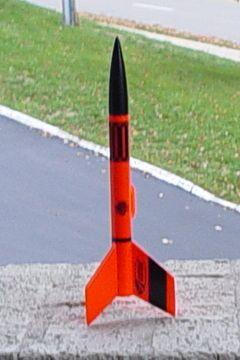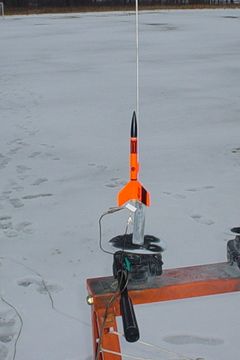| Construction Rating: | starstarstarstarstar |
| Flight Rating: | starstarstarstarstar_border |
| Overall Rating: | starstarstarstarstar_border |
| Diameter: | 0.54 inches |
| Length: | 7.80 inches |
| Manufacturer: | Estes  |
| Skill Level: | 1 |
| Style: | Sport |

Brief:
A step up from the fire and forget Mosquito, the Screamer is a mini-engine bird
that lives up to its name. Even with its mini engine power, this little rocket
is out of sight before the smoke hits the blast deflector. With its bright
orange paint it is a highly visible rocket, but with the kind of performance
that it is capable of, bright orange paint is only going to be of so much use.
Construction:
I used the following parts to build the rocket:
- BT-5P body tube (from Red Arrow Hobbies)
- BNC-5AX nose cone (from BMS)
- EB-5B engine block (from Red Arrow Hobbies)
- LL-2A launch lug (from Red Arrow Hobbies)
- small washer (from Lowe's)
- small screw eye (from Lowe's)
- 24" length Kevlar® shock cord (from Thrustline)
- decal (scanned from JimZ)
Construction of the Screamer is only slightly more difficult than building a Mosquito, but the end result is much more satisfying and looks like it will at least be recoverable. (More on that later.) It involves nothing more complicated than tying a length of Kevlar® cord around the engine block, then gluing the engine block in place with Elmer's wood glue. I attached the three fins using LocTite Gel CA, then filleted them in place with wood glue. The small washer was then attached to the nose cone with the small screw eye and the Kevlar® was then tied to the screw eye. After attaching the launch lug the Screamer is ready to fly if you aren't picky about paint.
Finishing:
Finishing could scarcely have been easier. After the tube spirals and balsa
grain had been eliminated with thinned Elmer's Fill 'n' Finish, the rocket was
sprayed with white primer. This is an important step because white primer
allows the florescent orange paint that I used next to glow to its best effect.
The unlabeled orange paint had been left over from my car modeling days and was
so old that I wasn't even sure it would spray but it worked like a champ. The
flat florescent paint sprayed on quite rough, so I lightly sanded the rocket
with fine grit sandpaper to smooth out the finish, then sprayed and sanded it
again. I then sprayed the nose cone with Valspar gloss black and after allowing
everything to dry, a coat of Valspar clear gloss. The orange and black of the
rocket's color scheme made a great contrast together and I was left with a
smooth surface to attach the decals. I printed the decal off on my home printer
using the scans from JimZ. The scans need to be cleaned up but that is a skill
I have yet to master. The spaces between the bands on the wrap decal looked a
little dark but not badly enough that they detracted from the looks of the
rocket.
Construction Rating: 5 out of 5

Flight:
While three flights is considered normal, it only took one flight for the
Screamer to show what it was capable of. I left home on the day of the flight
and encountered worsening weather conditions on the trip to the VOA. By the
time I arrived at the field, only two other fliers were still present and it
had begun to snow lightly. With the field already covered with snow from a
previous storm and three successful flights in the books already, I decided to
give the Screamer a chance. I had no doubt that the bright orange rocket would
show up well against the uniformly white coating on the ground and loaded it
with an A10-3T. This was a mistake. I should have chosen a much smaller motor
for the first flight because I never saw the rocket after it left the pad. I
heard the pop of the ejection charge and waited expectantly for the rocket to
drift back down and glow against the white carpet of snow. No dice. I began
looking over in the direction that the light breeze would have carried the
rocket but I found nothing except for a lost soccer ball. By this time it had
begun to snow harder and I got the distinct impression that I was the only one
on the field still interested in flying. I suggested that we strike the range
and after helping pack things up, I went back to my rescue mission. For the
next hour I walked a grid pattern for several hundred yards in the direction of
the breeze, hoping to spot an orange glow, but it wasn't to be. I never saw
anything of the Screamer again. It doesn't call or write.
Recovery:
PROs: Without a streamer in the body tube, packing the rocket is a snap.
CONs: Never recovered the rocket.
Flight Rating: 4 out of 5
Summary:
PROs: Great looks and performance. Cheap to build and fly. Easy to upscale.
CONs: Not a rocket to fly when you have the only eyes watching the skies.
Overall Rating: 4 out of 5
 |
 |
Flights
Sponsored Ads
 |
 |











